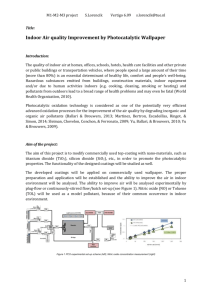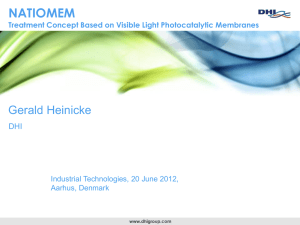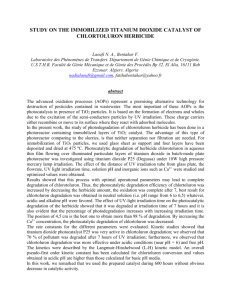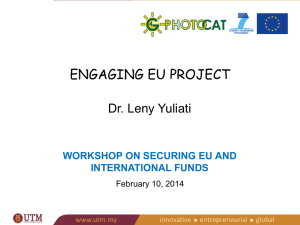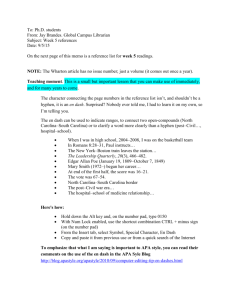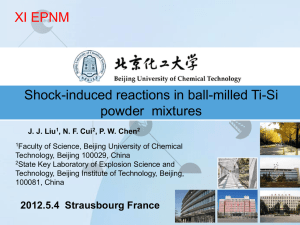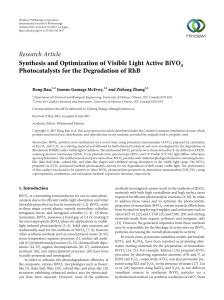Fig. 1: XRD patterns of BiVO 4
advertisement
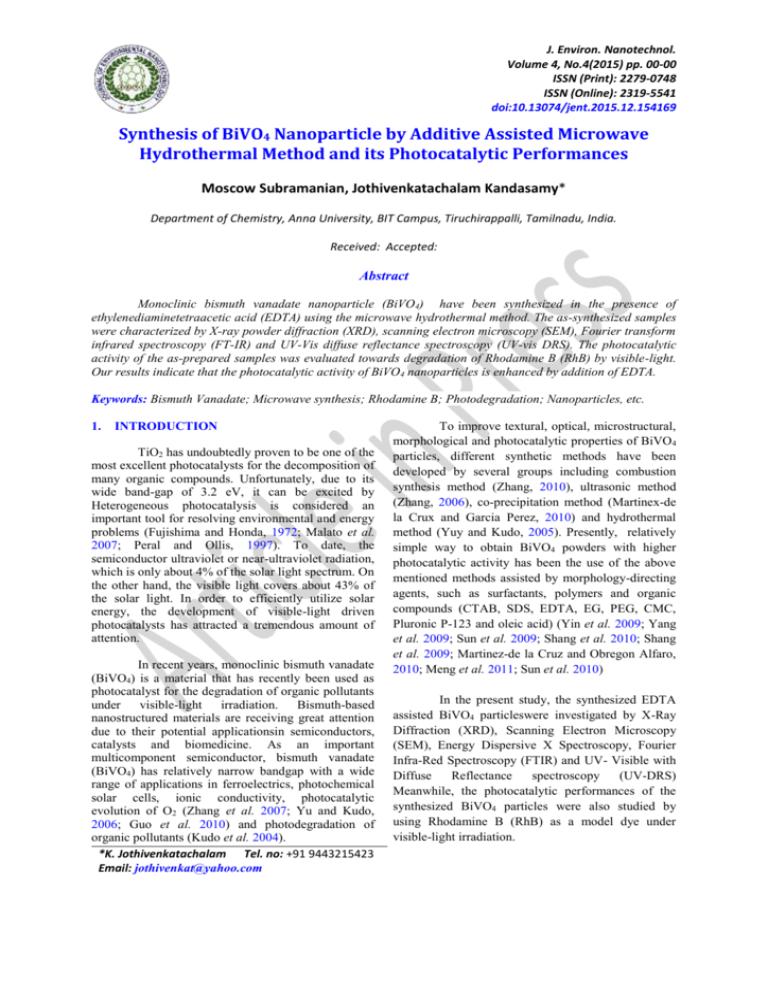
J. Environ. Nanotechnol. Volume 4, No.4(2015) pp. 00-00 ISSN (Print): 2279-0748 ISSN (Online): 2319-5541 doi:10.13074/jent.2015.12.154169 Synthesis of BiVO4 Nanoparticle by Additive Assisted Microwave Hydrothermal Method and its Photocatalytic Performances Moscow Subramanian, Jothivenkatachalam Kandasamy* Department of Chemistry, Anna University, BIT Campus, Tiruchirappalli, Tamilnadu, India. Received: Accepted: Abstract Monoclinic bismuth vanadate nanoparticle (BiVO 4) have been synthesized in the presence of ethylenediaminetetraacetic acid (EDTA) using the microwave hydrothermal method. The as-synthesized samples were characterized by X-ray powder diffraction (XRD), scanning electron microscopy (SEM), Fourier transform infrared spectroscopy (FT-IR) and UV-Vis diffuse reflectance spectroscopy (UV-vis DRS). The photocatalytic activity of the as-prepared samples was evaluated towards degradation of Rhodamine B (RhB) by visible-light. Our results indicate that the photocatalytic activity of BiVO4 nanoparticles is enhanced by addition of EDTA. Keywords: Bismuth Vanadate; Microwave synthesis; Rhodamine B; Photodegradation; Nanoparticles, etc. 1. INTRODUCTION TiO2 has undoubtedly proven to be one of the most excellent photocatalysts for the decomposition of many organic compounds. Unfortunately, due to its wide band-gap of 3.2 eV, it can be excited by Heterogeneous photocatalysis is considered an important tool for resolving environmental and energy problems (Fujishima and Honda, 1972; Malato et al. 2007; Peral and Ollis, 1997). To date, the semiconductor ultraviolet or near-ultraviolet radiation, which is only about 4% of the solar light spectrum. On the other hand, the visible light covers about 43% of the solar light. In order to efficiently utilize solar energy, the development of visible-light driven photocatalysts has attracted a tremendous amount of attention. In recent years, monoclinic bismuth vanadate (BiVO4) is a material that has recently been used as photocatalyst for the degradation of organic pollutants under visible-light irradiation. Bismuth-based nanostructured materials are receiving great attention due to their potential applicationsin semiconductors, catalysts and biomedicine. As an important multicomponent semiconductor, bismuth vanadate (BiVO4) has relatively narrow bandgap with a wide range of applications in ferroelectrics, photochemical solar cells, ionic conductivity, photocatalytic evolution of O2 (Zhang et al. 2007; Yu and Kudo, 2006; Guo et al. 2010) and photodegradation of organic pollutants (Kudo et al. 2004). *K. Jothivenkatachalam Tel. no: +91 9443215423 Email: jothivenkat@yahoo.com To improve textural, optical, microstructural, morphological and photocatalytic properties of BiVO4 particles, different synthetic methods have been developed by several groups including combustion synthesis method (Zhang, 2010), ultrasonic method (Zhang, 2006), co-precipitation method (Martinex-de la Crux and Garcia Perez, 2010) and hydrothermal method (Yuy and Kudo, 2005). Presently, relatively simple way to obtain BiVO4 powders with higher photocatalytic activity has been the use of the above mentioned methods assisted by morphology-directing agents, such as surfactants, polymers and organic compounds (CTAB, SDS, EDTA, EG, PEG, CMC, Pluronic P-123 and oleic acid) (Yin et al. 2009; Yang et al. 2009; Sun et al. 2009; Shang et al. 2010; Shang et al. 2009; Martinez-de la Cruz and Obregon Alfaro, 2010; Meng et al. 2011; Sun et al. 2010) In the present study, the synthesized EDTA assisted BiVO4 particleswere investigated by X-Ray Diffraction (XRD), Scanning Electron Microscopy (SEM), Energy Dispersive X Spectroscopy, Fourier Infra-Red Spectroscopy (FTIR) and UV- Visible with Diffuse Reflectance spectroscopy (UV-DRS) Meanwhile, the photocatalytic performances of the synthesized BiVO4 particles were also studied by using Rhodamine B (RhB) as a model dye under visible-light irradiation. Moscow Subramanian et al. / J. Environ. Nanotechnol., Vol. 4(4), 00-00, (2015) taken out and the absorbance of the centrifuged RhB solutions were monitored using a spectrophotometer. 2. EXPERIMENTAL METHOD 2.1 Synthesis of EDTA-modified BiVO4 samples 3. RESULTS & DISCUSSION BiVO4 was synthesized via the microwave hydrothermal method. Bi(NO)3·5H2O and NH4VO3 were the raw materials and EDTA was the additive in this process. The BiVO4 synthesized procedure was as follows: 5 mol of Bi(NO)3·5H2O and 1.0 g amounts of EDTA were added to a 100 mL beaker containing 20 mL of HNO3 aqueous solution (2 mol/L) while the solution was stirred. At the same time, 5 mol of NH4VO3 was added to another 100 mL beaker containing 20 mL of NaOH aqueous solution (2 mol/L). After both solutions became transparent, the two solutions were mixed and vigorously stirred for 30 min. The precursor was transferred to a 100 mL vessel for microwave heating treatment and the mixture was cooled to room temperature, filtered, washed with deionized water and absolute ethanol for three times, dried at 60 ℃ for 24 hrs and ground uniformly. At last, the obtained yellow powder was aged at 450 ℃ (heating rate of 3 ℃/min) for 4 hrs. 3.1 Crystal structure The crystalline structures of the as-prepared samples were examined by X-ray diffraction. The typical XRD pattern of the BiVO4 is shown in fig. 1, which is indicating that all the peaks well indexed to monoclinic phase of BiVO4 (JCPDS card No. 140688) and implying the purity of the samples. The overall morphology of the sample is composed of a wealth of relatively uniform monoclinic particles with diameters around 18 nm. These monoclinic particles are dispersed with a good poly dispersity, although some of them are broken, indicating that a high yield of crystalline can be obtained in the adopted reaction conditions. Counts VH 800 2.2 Characterization The crystalline phase of the sample was characterized by using the X-ray diffractometer (Bruker/AXS D8 Advance, Germany) with a Cu Kα X-ray irradiation source (λ = 0.15406 nm). Morphologies of the sample particles were determined by scanning electron microscopy (Gemini Zeiss Supra 55, Germany) operated at 10 kV. The Diffuse Reflectance Spectra (DRS) of the BiVO4 samples and the UV–Vis absorption spectra of the RhB solutions were obtained using a Shimadzu UV-2450 spectrophotometer. 600 400 200 0 20 30 40 50 60 70 Position [°2Theta] (Copper (Cu)) Fig. 1: XRD patterns of BiVO4 2.3 Measurements of the photocatalytic properties 3.2 Morphology studies The photocatalytic activity of the as-prepared sample was evaluated towards photodegradation of RhB in aqueous solutions at ambient temperature under visible light. The visible-light irradiation was provided by a 500 W tungsten halogen lamp with a 420 nm. Each experiment was performed as follows: 0.1 mg of BiVO4 photocatalyst was added into 100 mL of RhB solution with a concentration of 10 mg L-1. Before illumination, the suspension was stirred in the dark for 30 min to ensure adsorption/desorption equilibrium between dye and the photocatalyst. The suspension was vigorously stirred within the photoreactor during the process and temperature of suspension was maintained at 20 ℃ by circulation of water through an external cooling coil. At given time intervals 4 mL of the suspensions was The morphologies of as-prepared BiVO4 samples were observed using SEM and the results are shown in fig. 2. This reveals that the exterior surfaces of spheres are not smooth but contain an extensive growth of particles. The possible reason is that EDTA controls the formation rate of BiVO4. Bi3+ ions were chelated by EDTA, resulting in Bi3+ ions being desorbed slowly during the reaction. The diameter of an individual BiVO4 nanoparticle is about 20 nm which are consistent with the XRD investigations. Energy-dispersive X-ray spectroscopy (EDX) is relatively simple yet powerful technique used for the elemental analysis of a sample shown in fig. 3, which confirm the BiVO4 are composed by three elements in the catalyst is present such as Bi, V and O. 2 Moscow Subramanian et al. / J. Environ. Nanotechnol., Vol. 4(4), 00-00, (2015) out and the corresponding spectra are shown in fig. 5. Two bands at about 3389 and 1730 cm-1 is attributed to the stretching and deformation vibration of the O–H groups of chemisorbed and/or physisorbed water molecules. The tiny band appeared near 1600 cm−1 can be assigned to the presence of residual trace water in the structure. Fig. 2: SEM image of the BiVO4 Fig. 4: UV–Vis absorption spectra of BiVO4 Fig. 3: EDX image of BiVO4 3.3 Optical absorption studies 3.3.1 UV-Vis diffuse reflectance spectroscopy It is well-known that the optical absorption of a semiconductor is closely related to its electronic structure. The UV–Vis diffuse reflectance spectra of sample are shown in fig. 4, display strong absorption in the UV–Visible region from 200 to 600 nm. The steep absorption edge at 537 nm, indicates that the visible-light adsorption is due to the intrinsic band-gap (2.4 eV) transition. The steep shapes of the spectra indicate that the visible absorption is due to the band gap transition. The valence band (VB) of monoclinic BiVO4 is composed of hybridized Bi 6s and O 2p orbitals, whereas the conduction band is composed of V 3d orbitals. The absorption in visible zone is responsible for the high photocatalytic activity of monoclinic BiVO4 under visible light irradiation. Fig. 5: FTIR spectra of BiVO4 3.3 Photocatalytic reactions Photocatalytic activities of the samples were evaluated by measuring the degradation of RhB in aqueous solution under visible-light irradiation. Temporal changes in the concentration of RhB were monitored by examining the variations of UV-Vis absorption at 554 nm. Fig. 6 shows the results of degradation of RhB with BiVO4 under exposure of visible light. The characteristic absorption of RhB at 554 nm diminishes gradually with extension of the exposure time, and almost disappears after 180 min. It is clearly seen that with identical visible-light illumination, the BiVO4 show better activity is around 82% (fig. 7). Considering the photocatalytic degradation of organic dye in BiVO4 system, the 3.3.2 FTIR spectroscopy analysis To investigate the chemical composition and chemical bonding of composites, FTIR was carried 3 Moscow Subramanian et al. / J. Environ. Nanotechnol., Vol. 4(4), 00-00, (2015) mechanism may involve a direct reaction of dye with surface h+VB, an indirect reaction with OH• radicals, or a dual mechanism involving both surface h +VB and OH• radicals. preparation of new nanoparticles with a high percentage of activity which could be employed not only in photocatalysis, but also in energy conversion and water splitting and water purification REFERENCES Fujishima, A. and Honda, K., Electrochemical photolysis of water at a semiconductor electrode, Nat., 238, 37-38(1972). doi:10.1038/238037a0 Guo, Y., Yang, X., Ma, F., Li, K., Xu, L., Yuan, X. and Guo, Y., Additive-free controllable fabrication of bismuth vanadates and their photocatalytic activity toward dye degradation, Appl. Surf. Sci., 256, 2215-2222(2010). doi:10.1016/j.apsusc.2009.09.076 Kudo, A., Kato, H. and Tsuji, I., Strategies for the development of visible-light-driven photocatalysts for water splitting, Chem. Lett., 33, 15341539(2004). doi:10.1246/cl.2004.1534 Malato, S., Blanco, J., Alarcón, D. C., Maldonado, M. I., Fernández Ibáñez, P. and Gernjak, W., Photocatalytic decontamination and disinfection of water with solar collectors, Catal. Today, 122, 37149(2007). doi:10.1016/j.cattod.2007.01.034 Martínez-de la Cruz, A. and García Pérez, U. M., Photocatalytic properties of BiVO4 prepared by the co-precipitation method: Degradation of rhodamine B and possible reaction mechanisms under visible irradiation, Mater. Res. Bull., 45, 135-141(2010). doi:10.1016/j.materresbull.2009.09.029 Martínez-de la Cruz, A. and Obregón Alfaro, S., Synthesis and characterization of γ-Bi2MoO6 prepared by co-precipitation: Photoassisted degradation of organic dyes under vis-irradiation, Mol. Catal. A: Chem., 320, 85-91(2010). doi:10.1016/j.molcata.2010.01.008 Meng, X., Zhang, L., Dai, H., Zhao, Z., Zhang, R. and Liu, Y., Surfactant-assisted hydrothermal fabrication and visible-light-driven photocatalytic degradation of methylene blue over multiple morphological BiVO4 single-crystallites, Mater. Chem. Phys., 125, 59-65(2011). doi.org/10.1016/j.matchemphys.2010.08.071 Peral, J. and Ollis, D. F., TiO2 photocatalyst deactivation by gas-phase oxidation of heteroatom organics, J. Mol. Catal. A: Chem., 115(2), 347354(1997). doi:10.1016/S1381-1169(96)00330-5 Fig. 6: Absorbance spectra of RhB Fig. 7: Degrdation rate of BiVO4over RhB The pathway of photocatalytic degradation can be described by the following equations: BiVO4 + hv -- BiVO4 (h+VB + eCB) H2O + h+VB-- OH• + H+ h+VB /OH• +RhBoxidation products 4. CONCLUSIONS In summary, monoclinic BiVO4 nanoparticles with regular surface oriented nanoparticles were prepared by EDTA-assisted hydrothermal approach. The addition of EDTA is play a crucial role in determining the morphology, crystallinity and crystallite size. The as-prepared BiVO4 nanoparticles show enhanced photocatalytic activity for degradation of RhB under visible-light irradiation. Furthermore, the present study motivates us to explore microwave hydrothermal method for the 4 Moscow Subramanian et al. / J. Environ. Nanotechnol., Vol. 4(4), 00-00, (2015) Yin, W., Wang, W., Zhou, L., Sun, S. and Zhang, L., CTAB-assisted synthesis of monoclinic BiVO4 photocatalyst and its highly efficient degradation of organic dye under visible-light irradiation, J. Hazard. Mater., 173, 194-199(2009). doi:10.1016/j.jhazmat.2009.08.068 Yu, J. and Kudo, A., Effects of Structural Variation on the photocatalytic performance of hydrothermally synthesized BiVO4, Adv. Funct. Mater., 16, 2163-2169(2006). doi:10.1002/adfm.200500799 Yuy, J. and Kudo, A., Hydrothermal synthesis nanofibrous bismuth vanadate, Chem. Lett., 34, 850851(2005). doi:10.1246/cl.2005.850 Zhang, L., Chen, D. and Jiao, X., Monoclinic structured BiVO4 nanosheets: Hydrothermal preparation, formation mechanism and coloristic and photocatalytic properties, J. Phys. Chem. B., 110, 2668(2006). doi:10.1021/jp056367d Zhang, X., Ai, Z., Jia, F., Zhang, L., Fan, X. and Zou, Z., Selective synthesis and visible-light photocatalytic activities of BiVO4 with different crystalline phases, Mater. Chem. Phys., 103(1), 162-167(2007). doi:10.1016/j.matchemphys.2007.02.008 Zhang, Z., Wang, W., Shang, M. and Yin, W., Photocatalytic degradation of rhodamine B and phenol by solution combustion synthesized BiVO4 photocatalyst, Catal. Commun., 11, 982986(2010). doi:10.1016/j.catcom.2010.04.013 Shang, M., Wang, W., Zhou, L., Sun, S. and Yin, W., Nanosized BiVO4 with high visible-lightinduced photocatalytic activity: Ultrasonicassisted synthesis and protective effect of surfactant, J. Hazard. Mater., 172(1), 338– 344(2009). doi:10.1016/j.jhazmat.2009.07.017 Shang, M., Wang, W., Ren, J., Sun, S. and Zhang, L., A novel BiVO4 hierarchical nanostructure: Controllable synthesis, growth mechanism and application in photocatalysis, Cryst. Eng. Comm., 12, 1754-1758(2010). doi:10.1039/b923115c Sun, S., Wang, W., Zhou, L. and Xu, H., Efficient methylene removal over hydrothermally synthesized star like BiVO4, Ind. Eng. Chem. Res., 48, 1735-1739(2009). doi:10.1021/ie801516u Sun, Y., Xie, Y., Wu, C. and Long, R., First experimental identification of BiVO4·0.4 H2O and its evolution mechanism to final monoclinic BiVO4, Cryst. Growth. Des., 10, 602-607(2010). doi:10.1021/cg900988j Yang, T., Xia, D., Chen, G. and Chen, Y., Influence of the surfactant and temperature on the morphology and physico-chemical properties of hydrothermally synthesized composite oxide BiVO4, Mater. Chem. Phys., 114, 69-72(2009). doi:10.1016/j.matchemphys.2008.08.005 5
